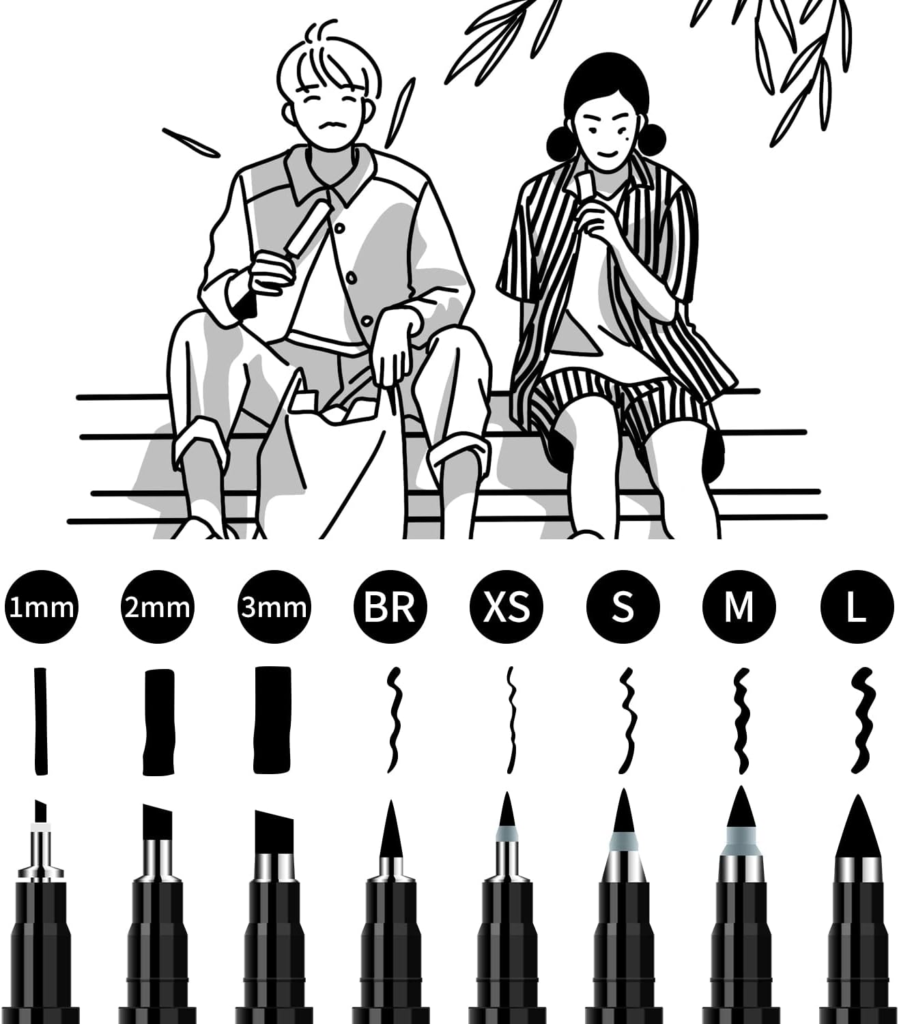Have you ever wanted to try calligraphy but didn’t have the right pen? Faux calligraphy is the perfect solution for you! This technique lets you create beautiful calligraphy using any regular pen, pencil, or marker. It’s easy to learn and doesn’t require any special tools, making it ideal for beginners.
Understanding Faux Calligraphy Technique
What is Faux Calligraphy?
Faux calligraphy is not about writing; it’s about drawing letters to look like real calligraphy. You can use any regular pen, marker, or pencil to create your letters. Then, you fill in what would normally be the downstrokes if this were done with a pointed pen. These thicker lines are called the shades.
Benefits of Faux Calligraphy
Faux calligraphy is easy to start because you don’t need special tools. Any normal pen or pencil will work, making it cost-effective. You can practice as much as you want without worrying about expensive supplies.
Common Beginner Misconceptions
One common misconception is that faux calligraphy is only for artists. The truth is, anyone can do it with a bit of practice. Another misunderstanding is thinking that faux calligraphy is the same as real calligraphy. While it mimics real calligraphy, it doesn’t require the same level of skill or tools. However, if you don’t understand how real pointed pen calligraphy works, your faux calligraphy might look a little off.
As a beginner learning how to do calligraphy we suggest picking up a calligraphy workbook for beginners. With a workbook you can monitor your progress and have real calligraphy examples to copy and learn from. Check out this workbook.
Essential Tools for Faux Calligraphy
Choosing the Right Pen
For faux calligraphy, you don’t need a special pen. Any regular pen will do the job. However, a rollerball or gel pen is a great choice because it’s easy to control and gives a fine line. Avoid flexible tools like brush pens, as they are not ideal for this technique.
Using Pencils for Calligraphy
A simple No. 2 pencil can be a fantastic tool for faux calligraphy. Pencils are great for beginners because they allow for easy corrections. Plus, you can create varying line thicknesses by adjusting the pressure.
Using Pencils to practice calligraphy can be a great way to perfect writing technique. Check out these professional sketching pencils here.
Markers and Other Alternatives
Markers, crayons, and even sidewalk chalk can be used for faux calligraphy. The key is to use a monoline tool, meaning every stroke is the same weight. This makes it easier to add thickness to your downstrokes later on.
The beauty of faux calligraphy is that you probably already have all the tools you need at home. From pens to pencils, and even markers, you can start practicing without any special equipment.
- Rollerball or gel pen
- No. 2 pencil
- Ballpoint pen
- Crayola crayon
- Sharpie
- Sidewalk chalk
Basic Techniques for Faux Calligraphy
Creating Downstrokes and Upstrokes
To start, write a word in your normal handwriting. Faux calligraphy is essentially the same as normal calligraphy, except you can do it without all the fancy nibs or brush pens. Any normal pen or pencil will work! Follow your word with your pen to see where the pen went down. These are your downstrokes. Leave any sideways strokes or upstrokes.
Adding Thickness to Downstrokes
Once you have identified the downstrokes, add a parallel line slightly offset from the original stroke. This will create the illusion of a thicker line. Then, color in the space between the lines to get the visual effect of a thick line. This simple technique can make your writing look like calligraphy.
Practicing Consistency
Consistency is key in faux calligraphy. Practice writing words with connected letters in cursive, trying to keep a little more space between the letters than normal. Over time, you will get better at making your downstrokes and upstrokes look uniform. Remember, practice makes perfect, so keep at it and don’t get discouraged.
When it comes to calligraphy, practice makes perfect! Practice the same letters over and over until it becomes second nature. If you need help practicing consider getting a calligraphy pen set.
Step-by-Step Guide to Faux Calligraphy
Writing Your First Letters
Start by writing out a word in either cursive or print. Make sure to leave a bit more space between the letters than usual. This will help when you add the downstrokes later. You can use any pen or pencil you have on hand.
Connecting Letters in Cursive
When writing in cursive, try to keep the letters connected smoothly. This will make your faux calligraphy look more natural. Remember, calligraphy is different from cursive, but for this guide, we’ll keep things simple.
Refining Your Technique
- Write your word.
- Identify the downstrokes by tracing over the letters in the air with your pen.
- Add a parallel line next to each downstroke.
- Color in the downstrokes to make them thicker.
With practice, your faux calligraphy will start to look more polished and professional. Keep practicing and refining your technique to master the art.
By following these steps, you’ll be able to create beautiful faux calligraphy even without a special pen. Ready? Let’s do this!
Advanced Tips and Tricks
Experimenting with Different Styles
Trying out different styles can make your calligraphy unique. Don’t be afraid to mix and match various fonts and techniques. This will help you discover what works best for you.
Using Guidelines and Templates
Guidelines and templates can be very helpful. They keep your letters straight and even. You can find many free templates online to practice with.
Incorporating Colors and Designs
Adding colors and designs can make your calligraphy stand out. Use colored pens or markers to add a splash of color. Simple designs like flowers or stars can also make your work more interesting.
Remember, practice makes perfect. Keep experimenting and practicing to improve your skills.
Common Mistakes to Avoid
Overcomplicating the Process
When starting with faux calligraphy, it’s easy to overthink the steps. Remember, simplicity is key. Focus on basic strokes and build from there. Trying to add too many details too soon can make your work look messy.
Inconsistent Stroke Widths
One of the most common issues is having uneven stroke widths. In faux calligraphy, downstrokes should be thicker, and upstrokes should be thinner. Using a regular pen, pencil, or marker without built-in flexibility can make this tricky. Practice consistently to avoid thick upstrokes or thin downstrokes.
Ignoring Practice
Practice is essential in mastering faux calligraphy. Skipping practice sessions can lead to slow progress and frustration. Dedicate time regularly to practice your strokes and letters. This will help you unleash your writing potential and achieve the style you’re aiming for.
Few calligraphers get it right all of the time. The key is to keep practicing and refining your technique.
Showcasing Your Work
Creating Calligraphy Art Pieces
Once you’ve mastered the art of faux calligraphy, it’s time to create some beautiful art pieces. Start with simple designs and gradually move to more complex ones. You can use your skills to make posters, greeting cards, or even wall art. The key is to practice and experiment with different styles and techniques.
Once you’ve mastered the art of calligraphy it’s time to show it to the world! You can write wonderful calligraphy gifts for friends and family on blank stretch canvas, they make wonderful gifts for both birthdays and Christmas – Use these Blank Canvas.
Making Personalized Gifts
Faux calligraphy is perfect for making personalized gifts. You can create custom name tags, bookmarks, or even framed quotes. These handmade items are not only unique but also show the effort and thought you put into them. Your friends and family will surely appreciate these special gifts.
Sharing on Social Media
Don’t forget to share your work on social media. Platforms like Instagram and Pinterest are great for showcasing your calligraphy. Use hashtags to reach a wider audience and connect with other calligraphy enthusiasts. Sharing your progress and finished pieces can also provide you with valuable feedback and inspiration.
Remember, the more you practice and share your work, the better you’ll become. Keep experimenting and have fun with your calligraphy journey!

Calligraphy Marker Pen Set – 8 Pens GREAT DEAL
Conclusion
In conclusion, you don’t need a fancy calligraphy pen to create beautiful calligraphy. With just a regular pen, pencil, or marker, you can practice and perfect your faux calligraphy skills. This method is not only cost-effective but also accessible to everyone. So, grab whatever writing tool you have on hand and start experimenting. Remember, the key is to have fun and enjoy the process of creating art with simple tools. Happy lettering!
Frequently Asked Questions
What is faux calligraphy?
Faux calligraphy is a technique where you mimic the look of traditional calligraphy using any regular pen, pencil, or marker. Instead of relying on special nibs or brushes, you create the illusion of calligraphy by adding extra strokes to your letters.
Can I use any pen for faux calligraphy?
Yes, you can use almost any pen for faux calligraphy. Ballpoint pens, gel pens, markers, and even pencils can work. The key is to create the thick and thin lines by adding extra strokes manually.
Do I need special paper for faux calligraphy?
No, you don’t need special paper for faux calligraphy. Regular printer paper, notebooks, or any paper you have at home will work just fine. However, smoother paper can help your pen glide better.
Is faux calligraphy hard to learn?
Faux calligraphy is quite easy to learn, especially compared to traditional calligraphy. With a bit of practice, you can quickly get the hang of creating beautiful letters and designs.
How do I make my downstrokes thicker in faux calligraphy?
To make your downstrokes thicker, simply draw an extra line next to each downstroke and fill in the space between them. This will create the appearance of a thicker line, mimicking the look of traditional calligraphy.
Can I use colors in faux calligraphy?
Absolutely! You can use different colored pens, markers, or even colored pencils to add a unique touch to your faux calligraphy. Experimenting with colors can make your work stand out and look more vibrant.




Leave a Reply
You must be logged in to post a comment.